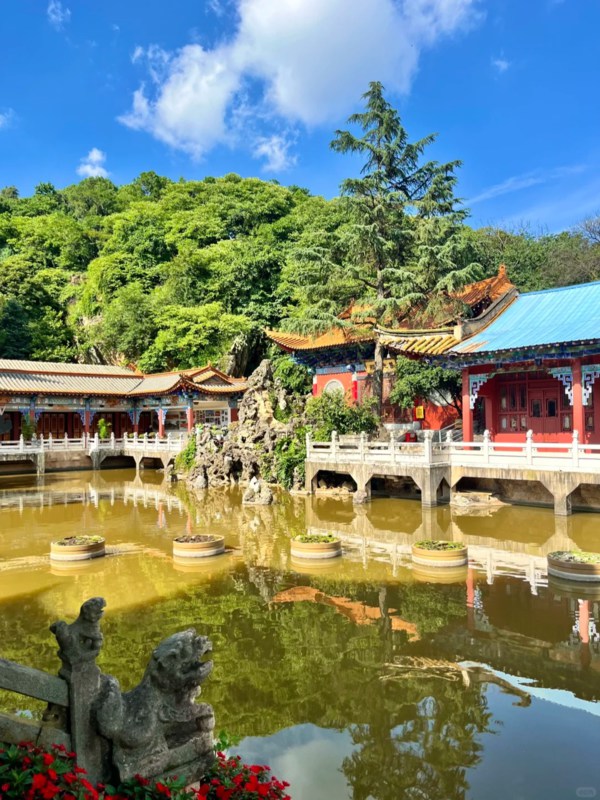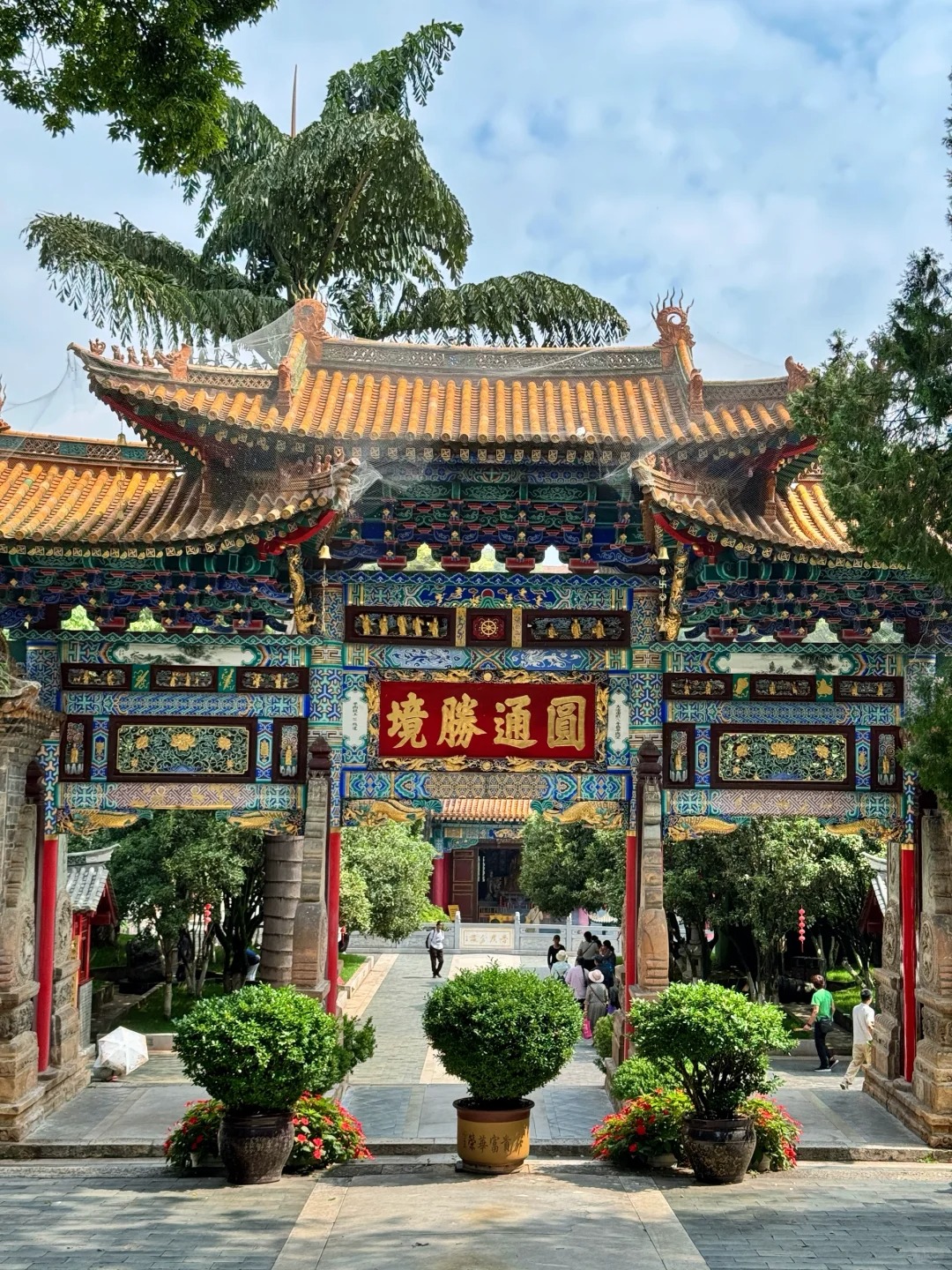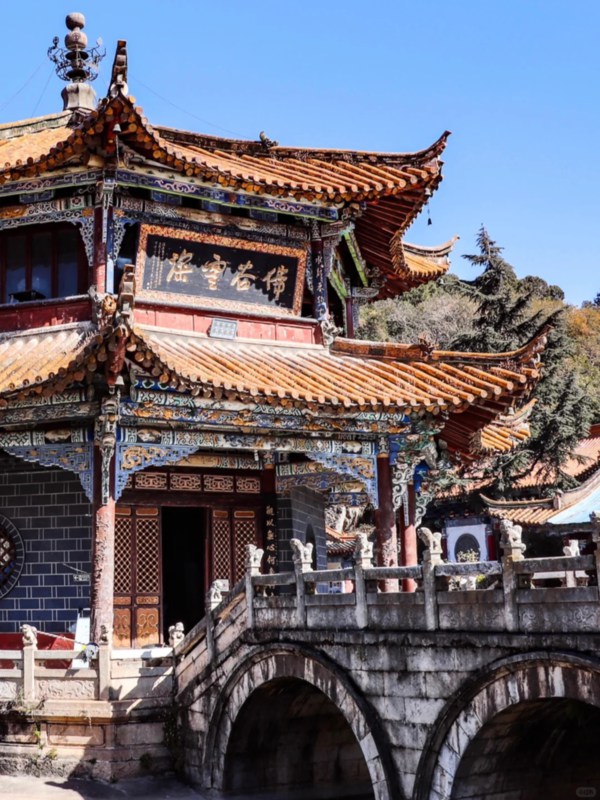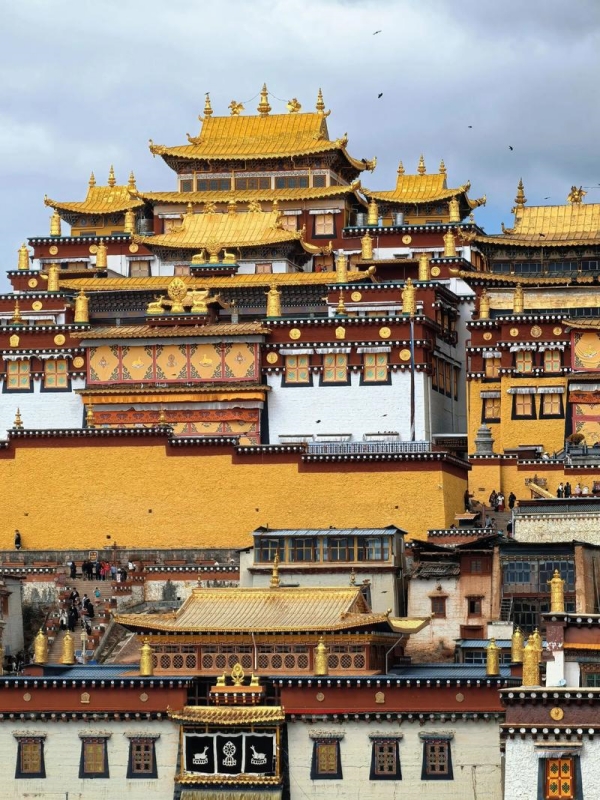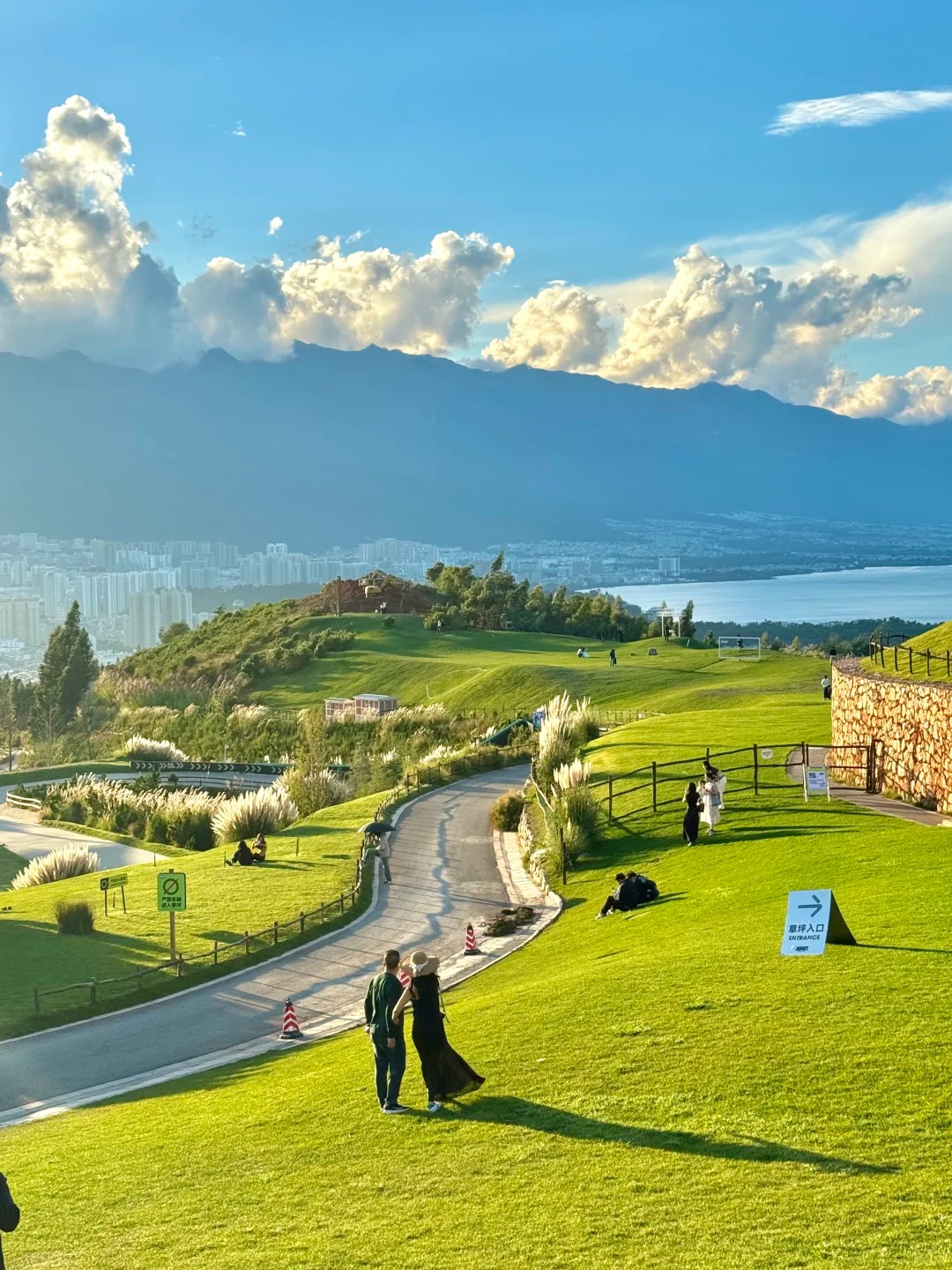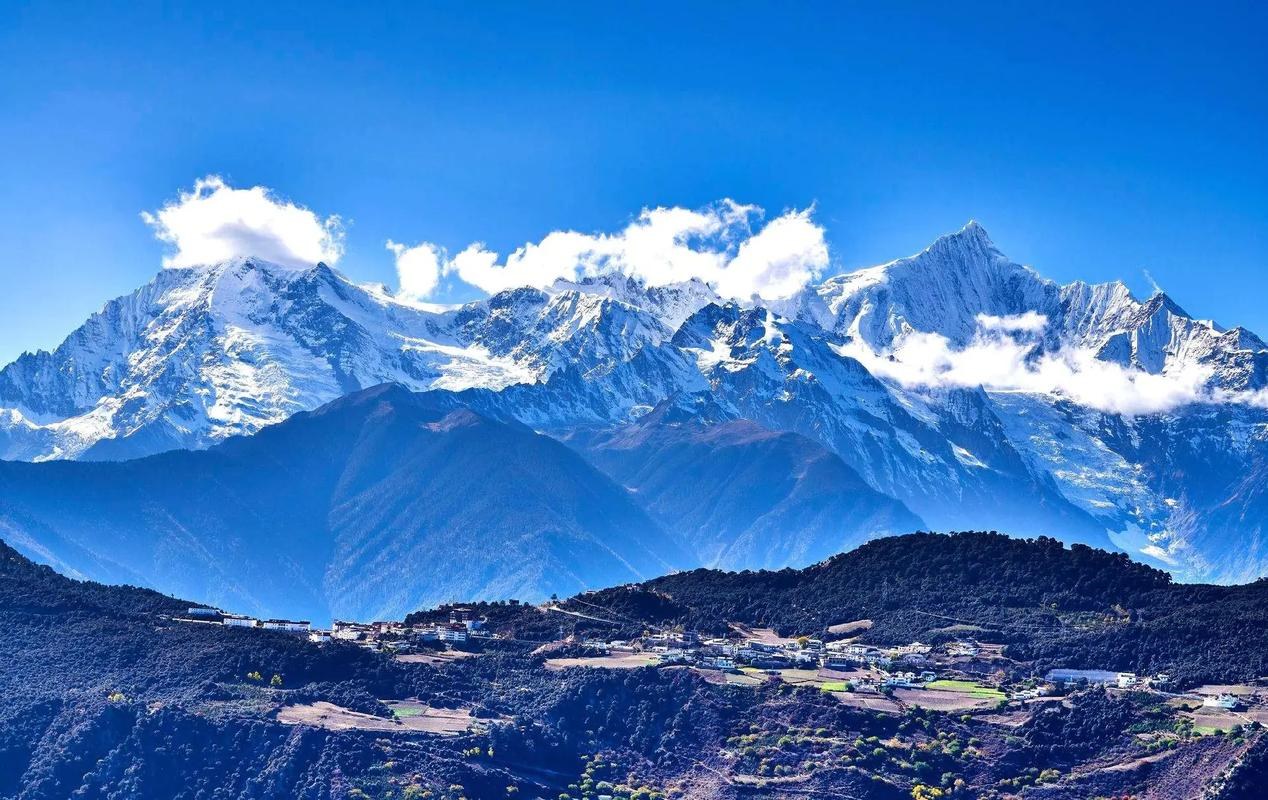
Yuantong Temple
Yuantong Temple stands at one end of Yuantong Hill, down at the quiet end of Kunming where the air feels cool and the traffic no longer sounds hostile. People readily repeat that it has “over 1200 years of history,” which is true, yet the figure does not reveal how strange and charming the place feels. The Nanzhao Kingdom gave Yuantong its beginning, and the monarchy of Yimouxun built it as an extension of an older temple. The Manchus later repaired Yuantong and kept the Yuan-Ming mixed style intact.
Walking through the temple today, you do not feel as if you stand inside a museum. The halls lean a trifle askew from age, and the courtyard stays redolent with incense and rain-wet stones. The layers of architecture create an impression when you move inside, and they somehow make sense, however peculiar the contrast may appear, once you stand within its walls.
Quick Facts of Yuantong Temple
| 🏯 Chinese Name | 圆通寺 (Yuantong Si) |
| ⏰ Opening Hours | 08:00–17:00 (may shift slightly on holidays) |
| 🎫 Entrance Fee | ¥6–10 depending on season |
| 📍 Address | Yuantong Street, Wuhua District, Kunming |
| 🌅 Best Time to Visit | 8–10 a.m. for soft light and fewer crowds |
| ⏳ Visit Duration | 60–90 minutes |
| 📸 Photo Highlights | Sunken courtyard, twin ponds, red beams |
| 🚶♂️ Nearby Spots | Green Lake, Yunnan University, Yuantong Hill |
What Makes Yuantong Temple Feel Different from Other Chinese Temples
- Outside of Yuantong Temple
- Water in Yuantong Temple
A Temple Built “Downward,” Not Upward – The Sunken Layout of Yuantong Temple
Most Chinese temples pull you up, with stairways evoking that someone decided, to reach enlightenment, one must do cardio. Yuantong Temple does the reverse. You enter it by walking down into it, and the first few steps change the mood completely. The yells and screams from Yuantong Hill disappear like spring snow within the first step, only to be replaced by the incense wafting upwards from the lower courtyard and the cool, slightly mossy smell present only in old stones which have undergone too many rainy seasons. The wind even sounds different—softer, as if the wind circles around the ponds before its cool fingers sweep the walkways.
Locals remark how the design is suited to “entering stillness,” which is indeed a pretty good way of indicating it. The deeper one goes down the steps, the more one feels the city being lifted off one’s shoulders. The waters amplify one’s footsteps, the halls drown out the traffic outside and the whole place seems to inhale rather than exhale. Perhaps this is why they remember the sunken layout long after they have forgotten the dates of the temple. If anybody asks why the design is important, this quiet pull downwards is more to the point than any printed page. And this, yes, is precisely the point about the charm of the architecture of Yuantong Temple when one is in the interior.
The Water, the Bridges, and the Silence – Why Local Buddhists Love This Temple
The twin ponds give this complex its emotional heart. They catch splashes of Kunming’s swift-changing sky, and the zig-zagging bridges force you to slow down even though you think you’re in a hurry. Locals take this area seriously — many walk directly to the water before going to the main hall. Bowing toward the pond first is a small habit, but it is one that I see so often that I notice it as part of the rhythm around here.
A Kunming uncle once told me that the water “remembers wishes better in the morning,” which I am still not quite sure how to take. But it fits the atmosphere. On TripAdvisor the talk is less of the statues than of how “the ponds, bridges, and quiet corners feel oddly soothing.” It is a deep kind of quiet — there is the splashing of koi, the tapping of shoes on stone, some bell tinkling somewhere, out of sight. Taken together this makes for an air of something personal. This is the reason the atmosphere at the Yuantong Temple seems so different to the traveller who is used to visiting temples quickly.
A Living City Temple — Where Students, Elders, and Travelers Cross Paths
Yuantong Temple in Kunming does not belong to that kind where it moves icily, like a lot of tourists. Students from Yunnan University slip in with their back-packs and whisper their formulas while lighting the quick sticks of incense before their examination. Older residents consider it a kind of morning bath, and some apply the same corridor every day, the one where the draught from Yuantong Hill blows through like a natural system of cold air. Others go down to the back halls without even glancing at the ponds, as if they have walked along this road for decades.
The ways of the travellers make their own imprints on the surface of things in diffusive kinds of ways. I once saw an elderly aunt quietly show a perplexed couple which burner they were to use and in what order, not a word issuing from her lips. It is nice to see such things as that, little bits of business that could not be scriptural, and they make you feel that the temple lives to-day instead of being stagnant. It is a city temple and a soul that breathes with its people to-day, and that is the reason it stays and hovers in your mind after you have left it.
History of Yuantong Temple
- Gate of Yuantong Temple
- Plaque of Yuantong Temple
From the Nanzhao Kingdom to Modern Kunming — 1,200 Years in One Courtyard
If you map the stones underneath your feet, the chronology gets dizzy quickly. The earliest layer pushes back into the Nanzhao Kingdom, when Yimouxun built a temple here in the late 700s. Then the Yuan rebuilt the halls, the Ming the courtyards, and the Qing refurbished more or less everything but kept the older bones beneath complected. By the time of the Republic of China, the place had already accumulated a number of architectural accents—none of which could have been painted on to much effect, but that somehow all belonged.
Walking through the place today is like turning the pages of several centuries at a walking gait. The hallways are Yuan, the pond railings seem more Ming, the painted brackets show the calmer style of the Qing which dominates Kunming. What surprised me on my first visit was the life it gives less of a museum impression. Everything is natural, nothing suggests a “preserved relic.” People walk, pray, gossip, sometimes dispute prices of incense, standing inside of more than a millennium of Yuantong Temple historicity which never makes any great effort to announce itself.
If you want to explore more about Kunming and what else you can do around the city, check out the things to do in Kunming guide, which has detailed recommendations and insider tips to make your visit memorable.
Influence of Multiple Buddhist Traditions in One Place
One of the unusual features here is that three Buddhist traditions are grouped together in a single compact area. Mahayana (汉传), Theravada (上座部), and Tibetan Buddhism (藏传) sit side by side in the halls. You can stand in the Mahavira Hall and see statues of so diverse an artistic lineage that some are tall and golden. Others are thick-set and suggest colors of Himalayan temples. This mingling of traditions is not usual in southern China, where the temples as a rule have an exclusively Mahayana aesthetic.
The position of Yunnan on the old trade routes has made this possible, and Yuantong Temple has brought it to a higher point of development. It has made it something of a system that functions naturally. One monk said to me, “We don’t separate people here by schools,” and looking around the place gives sufficient proof of his statement. The Yuantong Temple Buddhism therefore gains its culture somewhat from this aspect. It gains a sense of broader development than the average traveler can derive from a single temple visit.
What to See Inside Yuantong Temple (A Practical Walk-Through Route)
- Bridge of Yuantong Temple
- Sculpture of Yuantong Temple
Yuantong Shengjing Gate — The First Descent and the First Impression
The walk begins at Yuantong Shengjing Gate, and it appears somewhat banal at first sight. Yet the moment you pass the threshold the ground begins to level downwards. You feel this in your legs before the light changes perceptibly. A faint line of incense fumes generally hangs about such entrances with varying sweetness from the townsfolk’s offerings. The stone steps of Yuantong Gate remain slightly uneven and they cause a tendency on your part to proceed slowly. You are not sure whether centuries of footsteps have worn them down or whether the humidity of Kunming has caused the effect.
The air here becomes cold and it causes surprise to first-time visitors who arrive without expectations. The noise of Yuantong Street recedes so rapidly that it seems like a matter of preparation. It is not so when you listen carefully. And if you pause midway between the ground level and the lower temple you get a wide view of the courtyards below. They appear already a lively scene of gentle movement. To this effect the quiet magnificence of the Yuantong Gate owes its influence. It creates a small downward movement that leads you into a premise older than the city surrounding it.
The Twin Pools and the Zig-Zag Bridges — The Heart of the Temple
Reach the lower courtyard, and the twin pools are of a sudden visible, thus parting the temple like a mirror folded into the architecture. The water generally possesses a faint single green colour—it may be the green of the alga, or of the beams beyond—but holds it better than most temples I have known. If you are a photographer, this is the place where angles multiply: the red roofs, the curled shadows, the sky slashing into the water. Even people not interested in photographs will try at least one, standing on the zigzag bridges, unaware that everyone before them simply repeated the experiment.
The koi are magnificent owners of the situation. They slap very much, particularly when some food, in the shape of small pellets bought from the little stand near the corridor, is given them. These slaps rebound all round the stone railings, and mingle with the footfalls on the bridges. The zigzag business forces you to walk slowly, to sidle, and to adjust yourself. It is almost playful. And when the wind from Yuantong Hill brushes the water, you can see the patterns about that do not repeat themselves. There is a place much frequented by travellers which is “painfully peaceful.” This immediately suggests itself as the right place for Yuantong Temple pools, in the heart of the complex.
Mahavira Hall and the Mixed Buddhist Statues
The Mahavira Hall stands forward with a hum that you feel before you hear. Once inside, the first thing that attracts attention is that the statues do not share the same style. One is a slender and polished example of Mahayana work, and another shows the impossible Theravada simplicity. Another one has the bright colors and bold lines of Tibetan art. Three kinds of men worship in the same hall, and the effect is not a jumble. It becomes a sort of visual discourse when you stand there long enough.
Carefully observe the eyes of the central statue. They remain decoratively done and do not belong to the original figure. They have been painted in some other decade, and a monk told me that they had been touched up several times because strangers said they seemed “alive but tired.” It is a strange comment, yet you will find it believable after you study them long enough. Many tourists scamper through without theological savoring and miss the artistic notions cut in the wooden beams overhead. They also miss the musical squint of a bell in back of the hall. If you stay a few minutes after the important point of view appears, the main hall of the Yuantong Temple stops being a habit of tourist life. It becomes something of absorbing interest, the moment at which the past and present arrive at the same and practical breath.
Cultural Etiquette, Local Customs, and Things First-Time Visitors Should Know
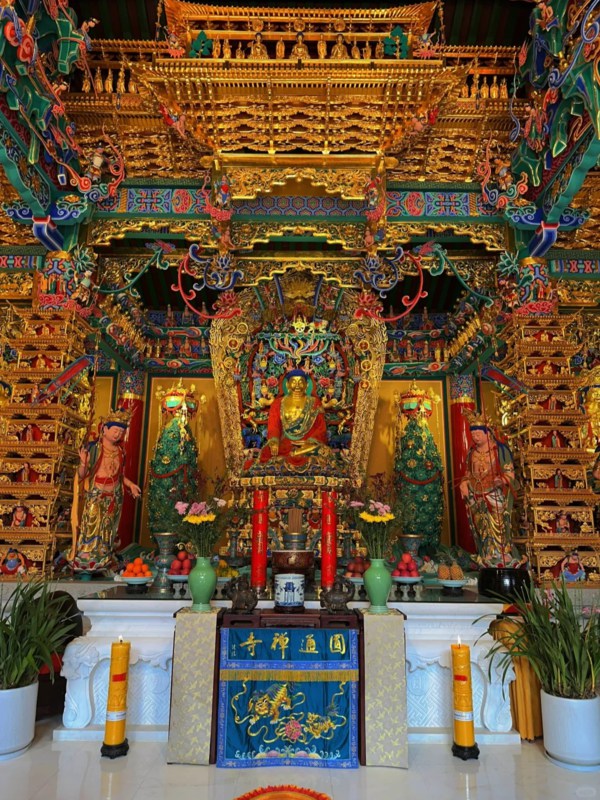
Inside of Yuantong Temple
How Locals Pray Here — The Subtle Rules Nobody Tells You
The daily rituals at the temple look simple, yet they involve certain practices that the ordinary traveller learns only by watching the ritualists for a time. The incense has its order, and you ignite it at the outer burner, then bow to the main hall before placing it carefully, not thrown, into the sand-box. You avoid stepping on the raised wooden strugs because this insults the guardian spirits, and the elderly aunts of Kunming will even drag you by the sleeve if you forget this rule and tread on it.
There is a lot of crowd business on the one and fifteenth days of the moon, and people gather at examination seasons before the dawn. You feel the common rhythm of prayer at these times, and you understand the necessity which makes the decorums of Yuantong pass from man to man instead of appearing on placards.
Photography, Drones, and Respecting the Monks — What’s Okay and What’s Not
Visitors seem to believe that temples welcome photography. Not true. It varies with the hall. The courtyards, the ponds, and the zigzag bridges are fair game but many of the inner halls ban photography altogether. A monk may, however, signal with a quiet hand signal kha bu (enough). Any use of drones is absolutely forbidden, despite the fact that maybe last year someone posted a groovy drone image from above. Security will immediately and without fanfare intervene. A close image of a monk (even) while he is chanting, or sweeping the stone paths, will be looked unfavorably upon. A solid guideline for Yuantong Temple photography is simple: if it seems personal, put the camera down and let the place breathe.
Common Mistakes Visitors Make (and How to Avoid Them)
The greatest mistake is coming at noon, when the overhead light washes out all reflection from the pools and makes all the colors harsh and ugly. Another is stopping at the entrance for a quick picture and never getting enough into the temple to see the bridges where the real mood of the temple is hidden. People often go without cash and are surprised to find that the incense vendors and small donation boxes do not take mobile payment, even though Kunming has a reputation for technology. Oddly enough, a few small bills will greatly enhance your experience here. For a better understanding of the cultural etiquettes and common practices at temples, especially when visiting Yuantong, check out the Chinese Etiquette guide. With these small Yuantong Temple tips in mind, you change a hurried hour into a peaceful, memorable, much longer hour than it appears to be on the clock.
FAQ About Yuantong Temple
Q: What time does Yuantong Temple Kunming open?
Yuantong Temple usually opens around 08:00, though I’ve seen the gates shift by a few minutes on busy festival mornings. Most locals arrive early because the courtyards feel cooler and the incense smoke hasn’t built up yet. By 9:30, tour groups start showing up from Green Lake or Nanping Street, so the first hour is easily the calmest time to slip in without feeling rushed.
Q: How long do people usually spend inside Yuantong Temple?
Most travelers stay 60–90 minutes, depending on how much time they linger at the ponds or the Mahavira Hall. Some students from Yunnan University finish a quick prayer in ten minutes and leave, while photographers can stretch a visit close to two hours if the reflections on the water are good. I’d say one full hour is the sweet spot for experiencing Yuantong Temple without rushing.
Q: Can you take photos inside the halls?
You can photograph the courtyards, bridges, and ponds freely, but the inside of the main halls is generally off-limits. A monk may lift a hand to signal you to stop, especially during chanting hours. Flash photography is frowned upon everywhere because it distracts people who come to pray. When in doubt, step back and take exterior shots instead—Yuantong Temple benefits from soft natural light more than indoor details anyway.
Q: Is Yuantong Temple similar to the Temple of Six Banyan Trees?
Both are historic urban temples, but the feeling is very different. Six Banyan Trees in Guangzhou leans heavily toward classic Mahayana aesthetics, while Yuantong Temple blends Mahayana, Theravada, and Tibetan influences in a single courtyard. The sunken layout also sets it apart; you descend into the complex instead of climbing upward. Travelers who’ve visited both often say Yuantong feels more lived-in and less like a formal landmark.
Q: How do I get from Yuantong Temple to Green Lake or Yunnan University?
Green Lake sits just southwest of the temple; walking takes around 12–15 minutes if you pass through Yuantong Park. Yunnan University’s historic campus is slightly farther, maybe 20 minutes on foot depending on which gate you’re heading for. The route is simple: follow the main road downhill toward the lake, then drift left. It’s one of the easier urban walks in Kunming, shaded and busy without being overwhelming.
Q: Is Yuantong Temple crowded during weekends or festivals?
Weekends bring steady crowds, but not the kind that crush you. Lunar day 1 and 15, however, get lively fast because locals come to burn incense before work. Exam season also draws students at odd hours, sometimes forming short early-morning lines near the entrance. If you want quiet pools and clean reflections, aim for weekdays before 10 a.m. That’s when Yuantong Temple feels closest to its calm core.
Q: Is there a dress code at Yuantong Temple?
There’s no strict written dress code, but modest clothing keeps you from standing out. Shoulders covered and knee-length bottoms are a safe guideline. People wearing very bright or flashy outfits sometimes get gentle looks from monks, especially near the inner halls. Hats are usually removed when stepping into prayer spaces. The general rule I’ve picked up is simple: dress in a way that doesn’t draw attention away from the atmosphere.
Q: Where is the world’s biggest Buddhist temple, and how does Yuantong Temple compare?
Borobudur in Indonesia is often cited as the largest Buddhist temple in the world, both by archaeologists and travel guides. Its scale is enormous, carved into a full stone mountain. Yuantong Temple, by contrast, is intimate—more of a living neighborhood temple than a monumental site. What it lacks in size, it makes up for in daily activity: locals praying, students dropping by, and a rhythm that feels woven into Kunming rather than towering above it.

